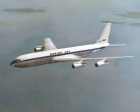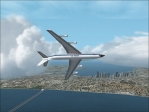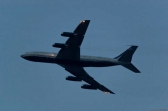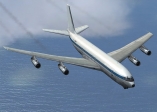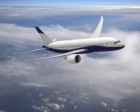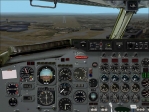
The Boeing 707 is a four-engine narrow-body commercial passenger jet airliner developed by Boeing in the early 1950s. Its name is most commonly pronounced as "Seven Oh Seven". Boeing delivered a total of 1,011 Boeing 707s including a smaller, faster model of the aircraft that was marketed as the Boeing 720.
Although it was not the first commercial jet in service, the 707 was among the first to be commercially successful. Dominating passenger air transport in the 1960s, and remaining common throughout the 1970s, the 707 is generally credited with ushering in the Jet Age. It established Boeing as one of the largest makers of passenger aircraft, and led to the later series of aircraft with "7x7" designations.
The Boeing 707 was an outgrowth of the Boeing Model 367-80. The "Dash 80" took less than two years from project launch in 1952 to rollout on May 14, 1954, then first flew on July 15, 1954. It was powered by the Pratt & Whitney JT3C turbojet engine, which was the civilian version of the J57 used on many military aircraft of the day, including the F-100 fighter and the B-52 bomber.
The prototype was conceived as a proof of concept aircraft for both military and civilian use: the United States Air Force was the first customer for the design, using it as the KC-135 Stratotanker midair refueling platform. It was far from certain that the passenger 707 would be profitable. At the time, Boeing was making nearly all of its money from military contracts: its last passenger transport, the Boeing 377 Stratocruiser, had netted the company a $15 million loss before it was purchased by the Air Force as the KC-97 Stratotanker.
The 132-inch (3,350 mm) fuselage of the Dash 80 was only wide enough to fit two-plus-two seating (in the manner of the Stratocruiser). Answering customers demands and under Douglas competition, Boeing soon realized that this would not provide a viable payload, so decided to widen the fuselage to 144 in (3,660 mm), the same as the KC-135 Stratotanker, which would allow six-abreast seating — and the shared use of the KC-135's tooling. However, Douglas Aircraft had launched its DC-8 with a fuselage width of 147 in (3,730 mm). The airlines liked the extra space, and so Boeing was obliged to increase the 707's cabin width again, this time to 148 in (3,760 mm). This meant that little of the tooling that was made for the Dash 80 was usable for the 707. The extra cost meant the 707 did not become profitable until some years after it would have if these modifications had not been necessary.
The first flight of the first production 707-120 took place on December 20, 1957, and FAA certification followed on September 18, 1958. A number of changes were incorporated into the production models from the prototype. A Krueger flap was installed along the leading edge between the inner and outer engines on early 707-120 and -320 models.
The initial standard model was the 707-120 with JT3C turbojet engines. Qantas ordered a shorter body version called the 707-138, which was a -120 that had six fuselage frames removed, three in front of the wings, three aft. The frames in the 707 were each 20 inches (500 mm) long, so this resulted in a net shortening of 10 ft (3 m) to 134 ft (41 m), 6 inches (41 m). Because the maximum takeoff weight remained the same 247,000 lbs (112 Tonne) as the -120, the 138 was able to fly the longer routes that Qantas needed.[10] Braniff International Airways ordered the higher-thrust version with Pratt & Whitney JT4A engines, the 707-220. The final major derivative was the 707-320 which featured an extended-span wing and JT4A engines, while the 707-420 was the same as the -320 but with Rolls-Royce Conway turbofan engines. British certification requirements relating to engine-out go-arounds also forced Boeing to increase the height of the tail fin on all 707 variants, as well as add a ventral fin, which was retrofitted on earlier -120 and -220 aircraft. These modifications also aided in the mitigation of dutch roll by providing more yaw stability.
Though initially fitted with turbojet engines, the dominant engine for the Boeing 707 family was the Pratt & Whitney JT3D, a turbofan variant of the JT3C with lower fuel consumption as well as higher thrust. JT3D-engined 707s and 720s were denoted with a "B" suffix. While many 707-120Bs and 720Bs were conversions of existing JT3C-powered machines, 707-320Bs were only available as newly-built aircraft as they had a stronger structure to support a maximum take-off weight increased by 19,000 lb (8,600 kg), along with minor modifications to the wing. The 707-320B series enabled non-stop westbound flights from Europe to the US west coast.
The final 707 variant was the 707-320C, (C for "Convertible") which was fitted with a large fuselage door for cargo applications. This aircraft also had a significantly revised wing featuring three-section leading-edge flaps. This provided an additional improvement to takeoff and landing performance, and also allowed the ventral fin to be removed (although the taller fin was retained). 707-320Bs built after 1963 used the same wing as the -320C and were known as 707-320B Advanced aircraft.
Production of the passenger 707 ended in 1978. In total, 1,010 707s were built for civil use, though many of these found their way to military service. The purpose-built military variants remained in production until 1991.
Traces of the 707 are still found in the 737, which uses a modified version of the 707's fuselage, as well as essentially the same external nose and cockpit configuration as the 707. These were also used on the previous Boeing 727, while the Boeing 757 also used the 707 fuselage cross-section. The Chinese government sponsored development of the Shanghai Y-10 during the 1970s, which was a near carbon-copy of the 707; however, this did not enter production.
Plane info
Cruise speed: 540 km/h
Total range: 3 680 km
Engines: 2 x Pratt & Whitney JT3C-7
Aircraft dimensions
Wingspan: 39.90 m
Length: 41.25 m
Height: 12.65 m
Cabin
Passengers: up to 140

